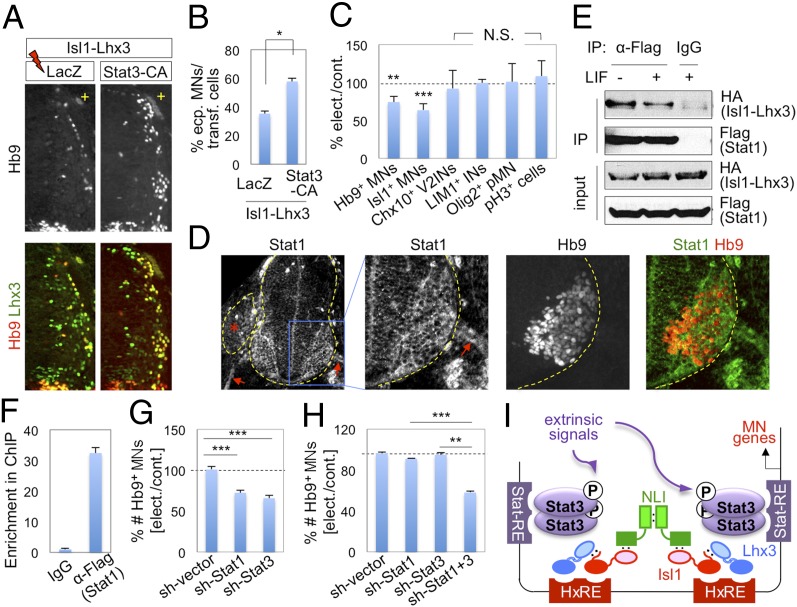Fig. 4.
STAT1 and STAT3 play important roles for MN differentiation in the developing spinal cord. (A and B) The immunohistochemical analyses of ectopic MN formation in chick spinal cord electroporated with Isl1-Lhx3 along with either LacZ control or STAT3-CA. Only the electroporated (+) side of the dorsal neural tube is shown (A). The expression of STAT3-CA increases the efficiency of Isl-Lhx3–triggered ectopic MN formation. (C) Analyses of chick spinal cord electroporated with STAT3-DNs. Inhibition of STAT3 activity using STAT3-DNs resulted in reduction of the number of Hb9+/Isl1+ MNs, but did not change the number of Chx10+ V2 interneurons, Lim1+ interneurons, Olig2+ MN progenitors, or pH3+ proliferation cells. (B and C) Error bars, SD; *P < 0.01, **P < 1.0 × 10−4, ***P < 1.0 × 10−5 in two-tailed Student t test; N.S., no significant change. (D) The immunohistochemical analyses of STAT1 in E10.5 mouse developing spinal cord. *Dorsal root ganglion; arrows indicate motor axons. (E) CoIP analyses in HEK293T cells transfected with HA-Isl1-Lhx3 and FLAG-STAT1. STAT1 associates with Isl1-Lhx3 independently of LIF. (F) ChIP assays in P19 cells transfected with Isl1-Lhx3 and FLAG-STAT1 and treated with LIF. STAT1 is recruited to Hb9-MNe. Error bars, SD. (G and H) Knockdown analyses in chicken embryos electroporated with shRNA constructs. Error bars, SEM; **P < 1.0 × 10−4, ***P < 1.0 × 10−5 in two-tailed Student t test. (I) The MN–hexamer and STAT3 collaborate to control MN gene transcription. STAT3 associates with the MN–hexamer and is recruited to the enhancers of MN genes, which have HxREs and STAT3-response elements (STAT-RE). This leads to the transcriptional cooperation to induce the expression of MN genes.

